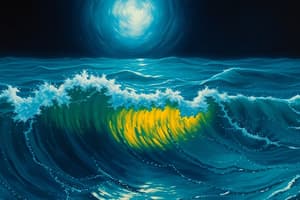Podcast
Questions and Answers
Which acronym does SONAR stand for?
Which acronym does SONAR stand for?
- Systematic Navigation and Ranging
- Sound Navigation and Ranging (correct)
- Systematic Observation and Ranging
- Sound Observation and Ranging
Who discovered the technique of echo sounding?
Who discovered the technique of echo sounding?
- Titanic
- German physicist
- Alexander Behm (correct)
- Fish biomass
What is the purpose of an echo sounder?
What is the purpose of an echo sounder?
- To detect icebergs
- To monitor fish passage at hydropower dams
- To determine the depth of water (correct)
- To measure fish biomass
When was echo sounding patented?
When was echo sounding patented?
What is the equation to calculate velocity?
What is the equation to calculate velocity?
Flashcards are hidden until you start studying
Study Notes
SONAR
- Stands for SOund NAvigation and Ranging
- A technique that uses sound waves to navigate, communicate, and detect objects underwater.
History of Echo Sounding
- Discovered by Lewis Fry Richardson around 1912
- He was a British physicist who had specialized in meteorology, but he had a fascination with sound.
Purpose of Echo Sounding
- Measures the depth of water
- This is done by emitting sound waves and measuring the time it takes for the echo to return
- This information is then used to create a map of the seabed
- Used in a variety of applications including:
- Navigation
- Fishing
- Oceanographic research
- Submarine detection
- Construction
Patent
- Patented in 1913 by Herbert Grove Dorsey
- He was an American engineer.
Calculating Velocity
- Velocity is the speed of sound in water
- Equation:
- Velocity = Distance / Time
- Distance: The distance traveled by the sound wave to the seabed and back
- Time: The time it takes for the sound wave to travel to the seabed and return
- Velocity = Distance / Time
Studying That Suits You
Use AI to generate personalized quizzes and flashcards to suit your learning preferences.




